Hello everyone,
Welcome to Issue #169 of CAFÉ ANNE!
It’s officially summer, so I thought I’d offer a little guide to enjoying NYC at its most sweltering—CAFÉ ANNE style.
As you know, locals typically opt for one of two strategies. Anyone with $$$ gets the hell out, escaping to the Hamptons (AI-generated folks), the Berkshires (crunchy), the Hudson Valley (AI generated, but harder to tell) or the Jersey Shore (people who do not give a f—).
Then there’s the folks who have no money but proudly declare they are enjoying a NYC “staycation,” enjoying all the city has to offer when the population thins out. “You can get a table at a restaurant!” They marvel. They rave about all the horrible free concerts in the park.
People, this is not the way. July and August are for minimal effort and low expectations.
My recommendations for your best NYC summer:
• Any dog run: There will be dog fights, people fights, a bossy, red-faced lady providing unsolicited training advice and, of course, lots of dogs doing hilarious dog things. Tip: bring a big, fat 19th-century novel for batting away overenthusiastic Labradoodles.
• The Dunkin’ Donuts at 116th Street in Rockaway Beach: This gem is right off the boardwalk. While everyone else is getting tan on the sand or “swimming,” I’m chillin’ in the AC, surrounded by vagrants, sipping the world’s worst iced coffee and checking stock trades on my iPhone.
• Any laundromat: If you’re over 30 and still hanging at the laundromat, it’s a good sign that life hasn’t worked out the way you’d hoped. And that means no one here will judge you! Throw a load in the washer, snag the plastic armchair out on the sidewalk and watch the world go by.
• The Red Hook Fairway: Okay, this supermarket is now the Red Hook Food Bazaar, but it’s still the best place to buy steam table chicken by the pound, grab a Diet Coke and spend an evening on the concrete patio overlooking New York Harbor. It’s the poor man’s Club 55!
• Reading on the couch: Nothing feels as luxurious as wasting a gloriously sunny afternoon in the greatest city in the world—reading on the living room sofa. It’s my way of saying I’m so rich, I drive a 1992 Camry. Tip: pick an anti-beach read, like Crime and Punishment—it’s like giving an extra middle finger to the whole notion of summer fun. Suggested snack: Beef Wellington.
In other news, London’s WatchHouse café chain has opened a new location in the Chrysler Building (!) and they are offering a $28 pour-over. This is the spendiest coffee I’ve yet to see in the city. I must try this ridiculous beverage, but cannot afford. Please contribute a few dollars to my Venmo (be sure to note it’s for coffee), and I’ll have a report for you soon!
I am very excited for this week’s issue, of course. It’s two graffiti tales in one! Please enjoy.
Regards!
Anne
The following are advertisements from CAFÉ ANNE sponsors.
BRAIN FOG DOESN’T MEAN YOUR STORY DISAPPEARS
That brilliant essay lives somewhere beneath the haze, and you *can* reach it. Join me for Writing Through Brain Fog—a 90-minute workshop for writers navigating cognitive challenges. We work with your mind as it is, not as it should be, providing practical tools for when thoughts feel scattered but your voice still matters.
STORIES FROM THE BODY
Your body remembers more than your brain does. In this free 5-day challenge (July 7–11), you’ll write five vivid, very personal stories and maybe even figure out where your memoir begins. Online. Weirdly satisfying. Possibly life-changing. But hey, no pressure.
Interested in advertising your product/service or promoting your own newsletter in the next issue of CAFÉ ANNE? Click here for details.
DEPT. OF HIGHER EDUCATION
My Afternoon Playing a Middle-Aged Vandal!
Lately, I’ve been cruising Airbnb's new "experiences" platform to check out the activities local New Yorkers are offering to tourists. It’s mostly the usual fare—bike tours, pizza tours, treks over the Brooklyn Bridge. And then I spotted something a bit more intriguing: "Spray Paint in Bushwick with a Local Street Artist!" The photo showed a young man in a hoodie, aiming an aerosol can at the camera.
Tourists taking graffiti lessons! This I had to see.
Before signing up, I looked into the company offering the workshop. Graff Tours, I read, offers "interactive activities to allow participants to get a taste of Hip Hop culture by creating authentic experiences led by local artists."
You can book a graffiti tour for your school group. You can arrange a "graffiti event" for your next Bar Mitzvah or corporate holiday party. "We offer team-building experiences for companies large and small," the company notes. "We have already worked with Google, Microsoft, Twitter, Estée Lauder, and more."
I signed up for the $45, one-hour Graffiti Art Workshop and imagined how thrilled my apartment-building neighbors would be when I tagged every dryer in the laundry room.
Graff Tours’s NYC studio is actually situated in East Williamsburg, an ideal location for a graffiti class. It’s one of the few neighborhoods in NYC that offers both $5 artisanal donuts and lots of graffiti.
On my walk to the studio, I observed tags scrawled across just about every mailbox, light pole and fire hydrant. The storefronts are graffitied, the warehouses are graffitied, the garbage pails are graffitied, the hydrants are graffitied.
And the Graff Tours building itself? Wowza. That's a lotta graffiti!
I was directed upstairs to a windowless studio the size of a single-car garage, where I met my fellow students. There was a young couple from France who didn't speak much English and a family from Seattle—a mom, her daughter and her daughter's husband. I asked the family what else they'd done in NYC.
"We've been to a show, we did Chinatown and the Banksy Museum yesterday," said the mom. "We always do a little bit of art mixed with shows and dinners."
"Do you think of this as art?" I wondered, indicating the graffiti-covered studio.
"Yes!" they said in unison.
The "local street artist" leading the workshop was a young lady dressed in cutoff overalls and orange-lensed glasses.
"I'm a street artist and graffiti artist here in New York," said Isabelle Ewing. "Do you know the difference between street art and graffiti? Anybody?"
We looked at each other and shrugged.
"Street art is legal, and I get paid to do commissions, to do murals all over the world," said Isabelle. "And then graffiti is technically illegal. You don't have permission to do it. You'll be arrested in New York."
Our first lesson: an introduction to the aerosol can. We learned to keep the nozzle's pinhole pointed away before pressing down. Then we advanced to higher-level concepts: speed, distance and pressure. The faster you go—and the closer to the wall—the skinnier and better defined the line.
"We're going to do what we call a free spray," said Isabelle. "Pick a color, any color, all the colors. Write your name! Play tic-tac-toe! Anywhere here on the walls."
I grabbed a can and scrawled my name in hot pink paint: "ANNE!" The French lady wrote, "amour.” Her husband, who was already quite deft with the spray can, drew a little cartoon character. "Minion!" he explained in his heavy accent.
The Seattle daughter, meanwhile, approached Isabelle with a concern. "It says on the can it should be used in a well-ventilated area," she said. "I don't know if I feel comfortable staying."
Despite Isabelle's reassurances, the whole Seattle family suddenly up and left. The workshop's first casualties! Now it was just me and the frogs.
We next learned the three basic kinds of letters: block, bubble and "wild style".
"When you see something on the street and you're like, 'What does that say?'—that's wild style," said Isabelle.
She demonstrated the styles and then it was our turn. "Grab one color for your fill and one for your outline," she said.
I asked for white and she shook her head. "Black and white we keep for teachers," she said.
I went with red and started on a big initial A—wild-style! It looked crazy.
"Walk before you run," said Isabelle. "Do a bubble letter or a straight one, then graduate to wild-style."
I tried to keep my "K" simple, but screwed this up too, neglecting to start with an outline as instructed.
"It's funny—even with graffiti, you have to color inside the lines," I said.
"Uh-huh," said Isabelle.
Of course I was curious to learn how Isabelle came to be a street artist. She grew up in Baltimore, it turns out, and had a graffiti-free childhood. She went to the Savannah College of Art and Design—one of the top art schools in the country—and graduated in 2014 before moving to New York.
"I actually was in fashion, and then I realized I hated the fashion industry, so I came here and saw all the graffiti and I was like, 'I want to do that.’ And to make a long story short, I wound up getting paid for it," Isabelle told me.
"I like the freedom of expression. It's also political, kind of," she said. "You know, f— the man. And it's so fun, and brings a childlike kind of energy. My inner child is very happy when I'm painting."
"Do you ever go out in the wild, do graffiti, tag buildings?" I wondered.
"Maybe. Maybe!" said Isabelle.
The final portion of the workshop had us each painting our own mural. Isabelle said she'd paint the outlines for us. I asked her to block out my blog name and coffee cup logo—block-letter style—and wondered if certain personality types prefer certain styles.
"I was just having a conversation with my coworkers about this," said Isabelle. "I think it has a lot to do with where you grow up. They were saying girls like bubble letters more. And people from Germany typically do the block letters."
I got to work filling in Isabelle's outline. It was tedious work. My trigger finger got very tired. Like almost all occupations, vandalism is harder than it looks!
I glanced at the French couple. They were painting their own mural—their daughter's name—over my initials!
I approached Isabelle again. "Hey, I got a question," I said. "What would happen in real life if I had just painted my initials, and then someone else came along and tagged right over it?"
"Oh there'd be trouble!" said Isabelle. "That's how you get into a fight!"
Hmm. I've been spending a lot of time at the gym, but there were two of them and just one of me. Also, they are parents and I am not, so they'd probably fight harder. I let it slide.
With Isabelle's help, I added highlights and shadows to my mural. I felt oddly pleased by the results. It looked like graffiti!
"I don't want to leave it behind," I told Isabelle, and she very sweetly offered to photograph me with my mural.
Before I leaving, I asked the obvious question: "What kind of feedback do you get from people who actually grew up on the streets doing graffiti?"
"It definitely brings them back," said Isabelle. "I think some people—some graffiti artists—think of it as selling out or something. But they probably just don't make money from their art. That's probably why they're mad."
"I have a friend who grew up in the city doing a lot of tagging—I'm curious what he'll think about this," I said. "I'm planning to give him a call."
"Oh yeah," said Isabelle. "Absolutely!"
Isabelle was introduced to graffiti as an art school grad in her 20s. My friend Will got started in the 1980s when he went to PS 173 in Washington Heights. He was seven.
"We were called The Devils," Will said of his crew when I rang him the next day. "Each of us was like, ‘Yellow Devil’, ‘Black Devil’—I was ‘Blue Devil.’"
Tagging was just one element of city hip-hop culture which included rapping and breakdancing. Nearly everyone joined a crew, but some took the tagging more seriously. "At the beginning, it was playing around, but then I took the path of making it an actual art form," said Will.
He hooked up with others who shared his interest and adopted a new tag: "IN," for "Incredible Negro."
"We wanted to become famous, to be well-known, and that meant you had to follow a specific path," said Will. "Besides improving our lettering, we had to put our tags or our pieces in specific areas that had the most visibility. That meant the sides of trains, train tunnels, and certain walls—wall-of-fame areas around the five boroughs.”
Hot spots included the Freedom Tunnel, an abandoned freight-train tunnel under Riverside Park, and the abandoned 91st Street subway station between the 86th and 96th Street stations on the IRT line.
“There's a lot of crazy motherfuckers out there who learned how to put their tag on top of a tall building, or a bridge, or the side of a police van,” said Will. “That's nuts!"
His tagging expanded to neighborhoods in Downtown Manhattan, Brooklyn and the Bronx. "But it'd be wise of you to know someone in those neighborhoods, because you could get in trouble," said Will. "You can tell if someone is not from your neighborhood. It's your mannerisms, your style. Kids can tell. It's being part of a tribe."
And he was careful where he tagged: "There's a lot of stories of graffiti writers being killed because it's a total disrespect to write over another writer’s piece.”
His writing grew from simple tags to "throw-ups"—more elaborate designs in bubble letters. "It's a quick way to put your tag on shop gates," said Will. "It takes about three minutes to throw one up. That's the whole point of it. You don't want to be caught by the cops."
Will referred to the most elaborate pieces as "burners." The mural I created at the workshop would be an example, he said. They take a while to complete and are typically seen in industrial areas that don't have a lot of traffic. "There might be a police presence, but you have two lookouts so they let you know cops are coming," he said.
The graffiti scene was small back in the 80s. Traveling the city, Will knew the names behind the tags of all the best-known writers. "And I was definitely getting to the point where I was becoming well known, at least in my neighborhood," he said.
And then he turned 16, and stopped. "I just grew out of it," he said. "I was more focused on college. I didn't want to get in trouble, get arrested. There comes a point, if you want to get famous, you have do things that increase the possibility of getting arrested."
"Did you ever get arrested?" I asked.
"Not for graffiti!" said Will.
I was curious to get Will's take on the graffiti workshop I'd taken, of course.
"Do you think it's funny?" I asked.
"100 percent!" said Will "It's just weird! It's like people are taking classes to learn how to do something that we just figured out ourselves."
But his overall response was more nuanced.
"It's good and it's bad," he said. "It's inevitable."
Will, a technologist, filmmaker and storyteller, said it’s been fascinating to observe as graffiti culture was fetishized by the downtown gallery scene, produced internationally-known characters such as Banksy and is now seen as a stepping stone for artists like Neck Face and Shepard Fairey designing for streetwear companies.
But painting in a studio or getting a street mural commission divorces the practice from its roots, he said. "You don't have to worry about being arrested, about being killed. It takes away all the dangers of the beginnings of graffiti and puts it in a safe space. It's missing a specific essence that might be vital to the art form."
On the other hand, a tourist who takes a graffiti class might get interested in the movement’s history, he speculated—the way someone taking jazz drumming lessons might start appreciating some of the early jazz greats.
"All I can hope for is whoever is doing these classes and tours is giving people a real history," he said. "Overall, I'm hopeful. I'm optimistic."
And he still enjoys observing the evolving graffiti culture on the streets, even if stickers have emerged as the new medium.
"It's weird—I'm still attached to it in some capacity," he said. "I feel the urge to do a quick tag for old time's sake!"
QUOTE OF THE WEEK
“You don’t have much control of the tide. Even the men in suits keep getting random results.”
—Dennard Dayle
CAFÉ ANNE is a free weekly newsletter created by Brooklyn journalist Anne Kadet. Subscribe to get the latest issue every Monday.


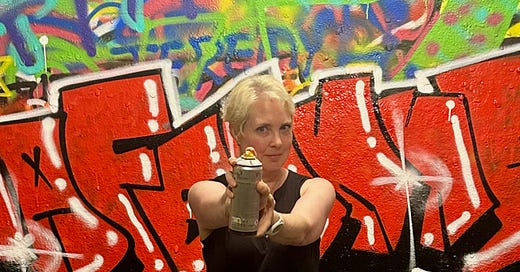











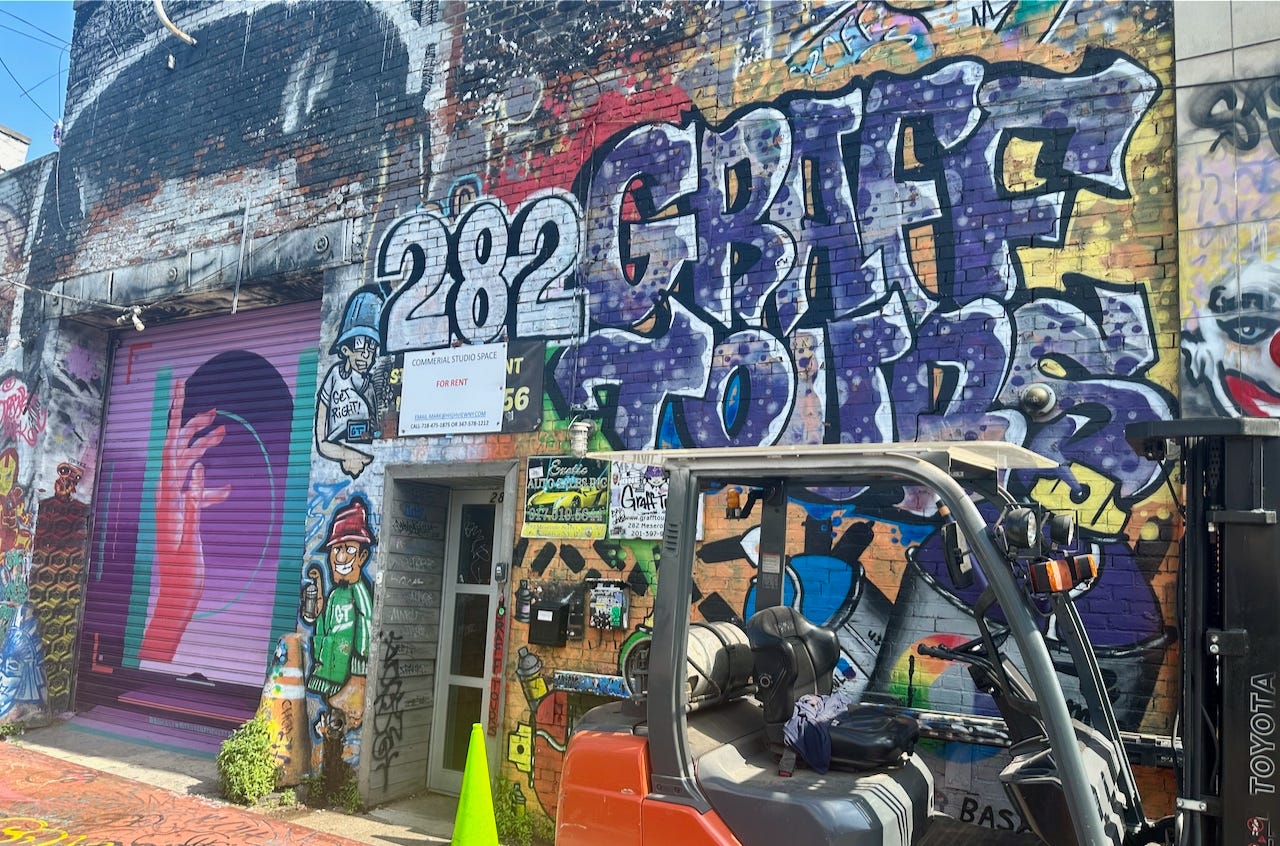
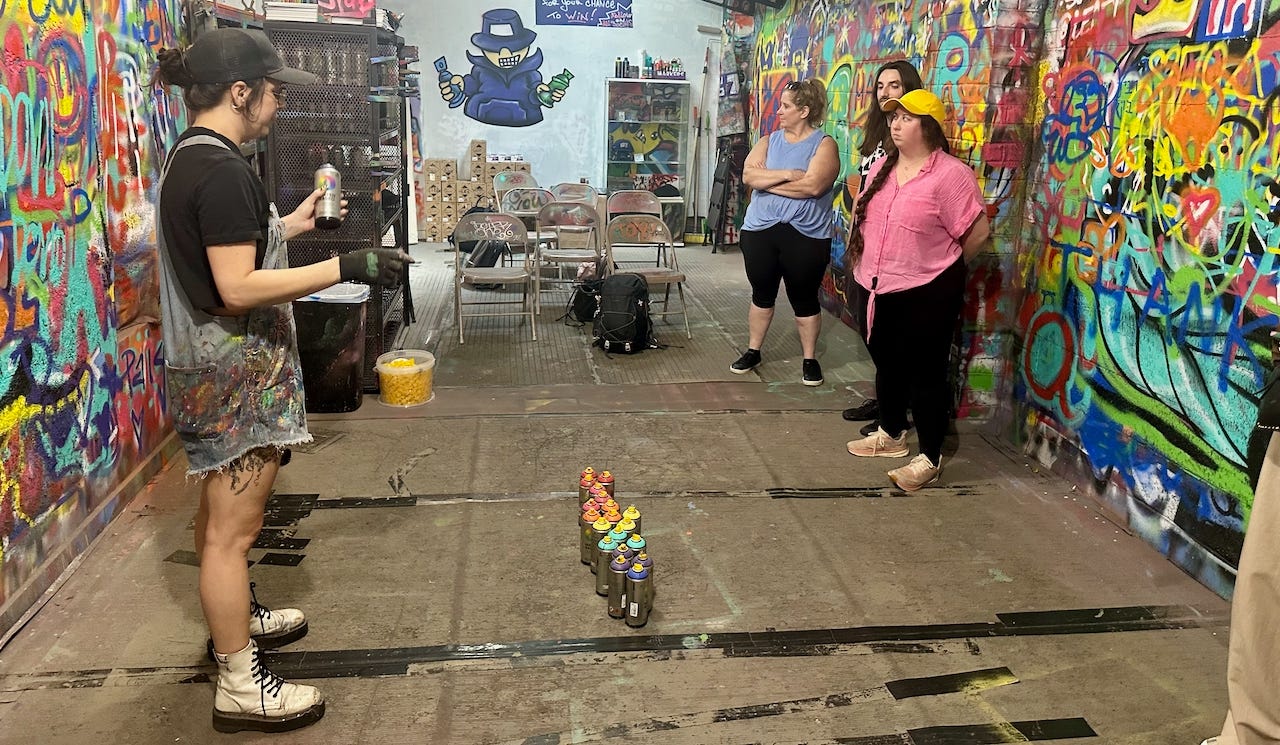



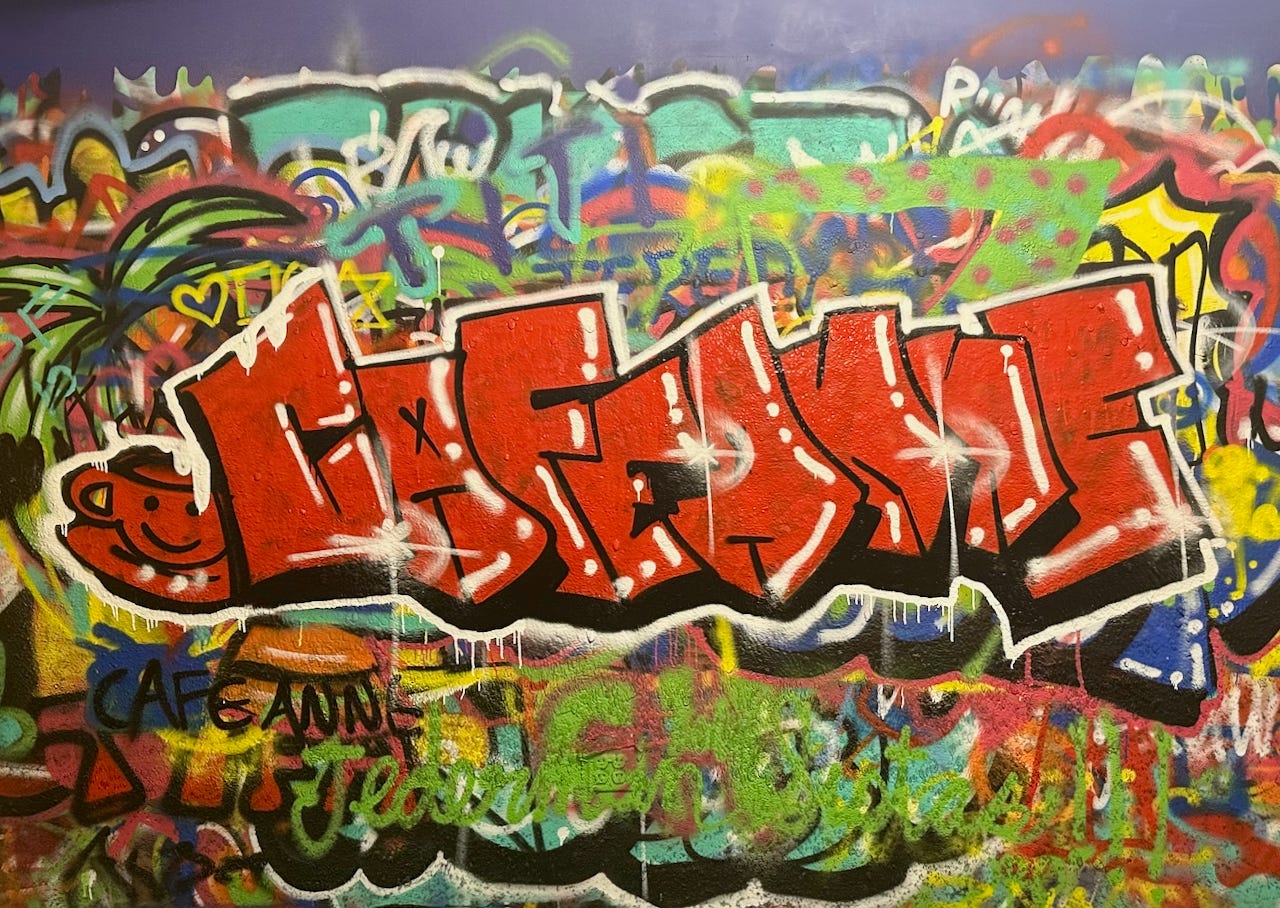

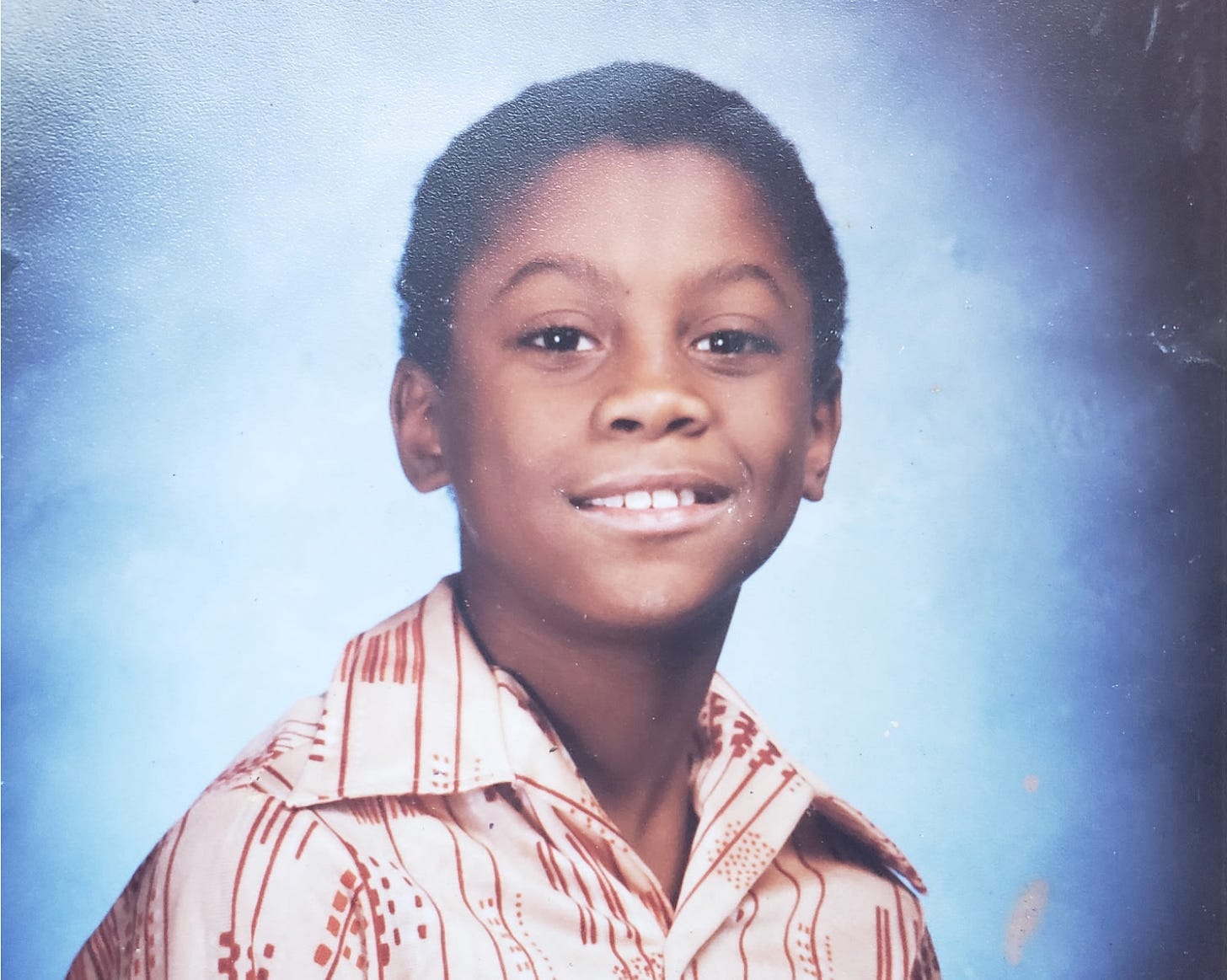




I love that you shared both Will and Isabelle's perspectives on graffiti! They both practice a similar art form, but even Isabelle mentioned the difference between what she does (street art) and what Will did (graffiti).
Also - I met with my Cafe Anne match, Adam, over the weekend, and I have to say the match was a good one! Adam suggested we walk around Evergreens Cemetery to see some famous graves and one of the highest points in the neighborhood, which felt like a very Cafe Anne move. We got along great and will definitely be hanging out again! Also - Adam and Eden, feels like it was meant to be?
I love that we get the art student and newbie perspective AND the experienced street artist perspective with the added twist of looking back on it with some years behind you. What a cool juxtaposition of experiences.
I've always been fascinated by train graffiti. It's like a traveling art show when you're stopped at the gates. I've seen art that has made me laugh, made me mad, and made me feel like I'm a part of something much bigger. It honestly adds a lot to many experiences, whether legal or not.